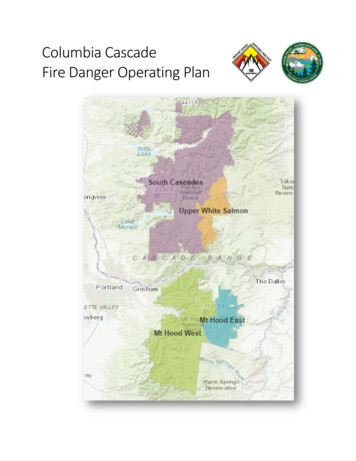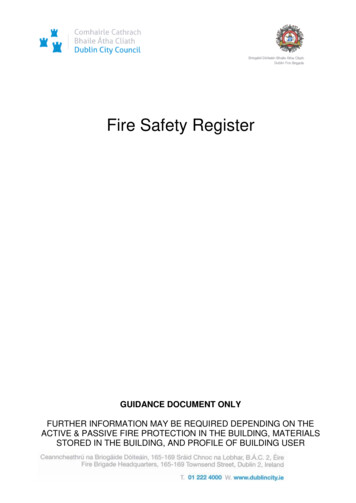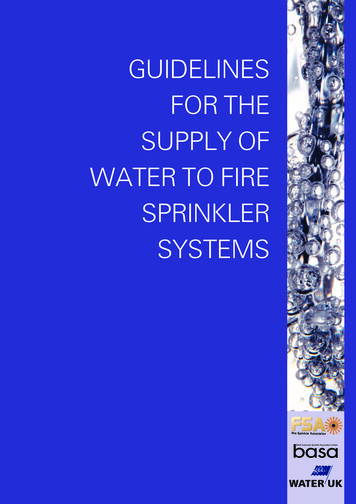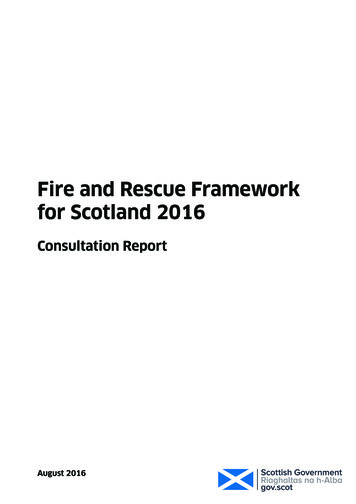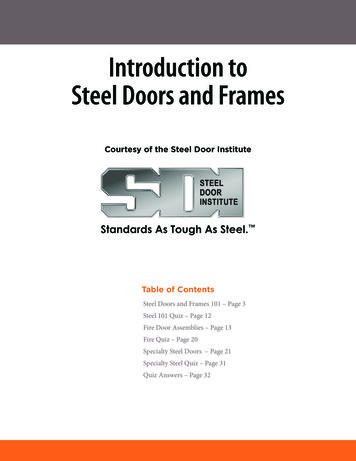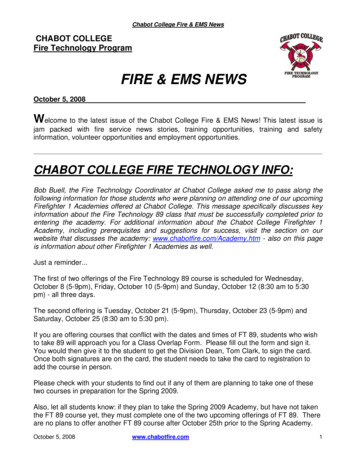
Transcription
NFCCLeadershipFramework
Fire CentralProgramme OfficeInspiring Leadershipin the Fire andRescue Service
01ForewordThe National Fire Chiefs Council(NFCC) People Strategy hassix key areas for improvements: Strengthen leadership and line managementto support organisational change and improvedcommunity outcomes Develop cultural values and behaviours whichmake the fire and rescue service a great placeto work for all our people Develop ways of working that are able torespond to service needs Provide excellent training and education toensure continuous improvement of servicesto the public Continue to support the health and well-beingof all our people Strengthen our ability to provide good serviceby diversifying our staff and creating a fair andequal place to workLeadership is key to all of these areas and has neverbeen more important at every level of the fire andrescue service. Delivering an excellent service toour community, and being adaptable to the evolvingrequirements of a ‘modern fire and rescue service’is key to our leadership and management focus forthe future.More than ever before, we need leaders whoare both operationally and professionally competentas well as being capable of creating and deliveringa compelling vision for the future to inspire andmotivate others. We need resilient leaders who willtake responsibility for continuous improvement inour performance as a public service and bring otherpeople with them.We need leaders who are able to collaborate acrossour different functions internally as well as being ableto cross traditional boundaries with other agenciesand businesses to achieve more efficient, effectiveand joined up services for the communities we serve.This document introduces our new LeadershipFramework, which clearly defines the leadershipbehaviours required at each level of management.This framework details a simpler set of behavioursand sets out the career planning process to supportindividuals who are looking to develop their careerwith the service.Leadership is not defined by what courseswe have attended or what qualificationswe have achieved, but instead by thedifference we are making to the peoplearound us.The new Leadership Framework links to the new‘Core Learning Pathways’ which can be used tosupport our next generation leaders.In setting this framework, we recognise thatthroughout our career there is always somethingwe can focus on to improve. This means a changein focus from outputs to outcomes – leadership is notdefined by what courses we have attended or whatqualifications we have achieved, but instead by thedifference we are making to the people around usand to the performance of the team and organisation.This difference is then ultimately experienced by ourcommunities through improved service delivery.Roy WilsherChair of National Fire Chiefs Council
02SupportingdevelopmentDevelopment andcareer planningprinciplesFire and rescue services arecommitted to supporting thedevelopment and progressionof all staff and ensuring a fairand consistent approach toperformance and promotion.Everyone should takeresponsibility for their owndevelopment and career pathwayand managers should supportthem in providing opportunities.This relies on managers and staff using theirappraisal system to discuss performance, careeraspirations and readiness for progression from allaspects, including against the appropriate level inthe Leadership Framework. This approach will ensurewe identify those ready for progression, with both thetechnical ability and leadership behaviours matchedto the future needs in the fire and rescue service, andthat we measure performance of all staff against theLeadership Framework.As a sector committed to continuous improvement,all staff (not only those applying for promotion) shouldhave a structured development plan. This shouldlook at what may support the individual to be moreeffective in their current role, adapting to the evolvingrequirements of a modern service, as well as whatis required for progression. This consists of eitherprofessional, operational or behavioural development.Development should be tailored to the individual.Fire and rescue services offer a wide variety oflearning and development which is not limitedto courses and qualifications, but could include360 developmental feedback, guided researchundertaken, participation in an action learning set,placements within a different organisation, coachingand mentoring (either giving or receiving), andproject or assignment work.Managers and staff need to use regularappraisal discussions to discuss personal careeraspirations and readiness for progression usingall available performance evidence and theLeadership Framework.Individually tailored development plans shouldbe completed to help develop the specific skillsneeded to be successful in your career choices.Promotion will be based on having experience,effective behaviours, and evidence to meet thenext level requirements – not just by attendingcourses. Development will not be limited to simplyattending courses or achieving specific qualifications.It can include deeper learning experiences suchas taking part in a work based project, actionlearning sets to work on particular issues, accessto a coach or mentor and various work assignmentsor secondments.
03Four levelsof leadership:Leading the ServiceTo lead the organisation forward inan evolving operating environment,we need individuals who arecapable of: Creating a compelling vision and engagingpeople to buy in and commit to that vision Leading across boundaries Are adaptable within an evolving modern Service Utilising high levels of emotional intelligenceto support people in achieving the goals ofthe organisationFocus on developing skillsto support and leadcorporate change.Leading the FunctionFocus on developing skillsfor setting direction and visionfor the department, monitoringand improving performanceand wellbeing.e.g., station/group managers,departmental managers Being in the present, but also horizon scanning Promoting and developing distributed leadership(i.e. leadership at all levels) Acting as ambassador for learning throughboth personal practice and creating andsustaining learning organisations Embracing inclusion, diversity, innovation,and being open to alternative perspectives Demonstrating and promoting compassion for‘self’ and others, with a focus on improvementand accountabilityThe intention is to devise common specificationsfor core development modules, based on identifiedneeds, which will be relevant to all managers acrossthe organisation. The ultimate aim of the programmeis to make development support available to allmanagers within a given level. There will be a focuson blended learning which maximises use of differentlearning methodologies to enhance learning.Leading OthersFocus on people management,legal and ethical framework,personal leadership skills andpersonal resilience.e.g., crew/watch managers,first line managersLeading YourselfFocus on induction and localfoundation. Management andstaff development modules.e.g., firefighters, entry level staff
04Introducing theLeadership FrameworkPersonal Impactensures we value, respect and promote equality anddiversity. It’s about being a positive presence onothers, having personal integrity and an ability toself-manage. The focus is on self and how a manageruses leadership to create a positive, open-workingenvironment focusing on ethics and wellbeing.PersonalImpactOutstanding Leadershipis about building high-performing teams and developingpeople to their full potential. It’s about communicating withintegrity, being open and honest to foster trust and buildingcollaborative working partnership. An ambassador androle model for the fire and rescue service. The focus is onothers and how a manager uses leadership to create highperformance teams.OutstandingLeadershipOperationaland rviceDeliveryOrganisational EffectivenessService DeliveryThe Leadership Framework replaces the PersonalQualities and Attributes (PQAs), making them simpler,and provides a consistent approach to leadership anddevelopment for all staff, irrespective of discipline,role or function. The framework brings together the‘what and the how’; combining traditional operationaland professional competence with behaviouralexpectations. The behaviours are described belowand the Core Learning Pathways are outlined in aseparate document.The framework is built around four quadrants asabove, and is measured at four levels, with eachbuilding on the previous. The critical feature of thefire and rescue service Leadership Framework isthat it’s relevant to all fire and rescue service rolesand uses defined and observable measures toassess the potential and performance of our staff.is ensuring everything we do is linked to organisationalplans and values. It’s driving the mission and ensuringdecisions and actions are beneficial to the customer.The focus is on the organisation and how a manager usesleadership to continuously improve, innovate and change.is about delivering high quality services now and into the future.It’s about intelligent problem solving with an outcome focussedapproach, continuous improvement and value for money toour customers. The focus is on task and how a manager usesleadership to produce outcome-focussed results which meetcustomer needs.
05Personal Impact – this is about selfLeading Yourselfinclusion and set Iavaluepositive example ofappropriate behaviour forpeers and new starters.Leading Otherstake responsibility for Iinclusion,and encouragedifferent points of view.Leading the Functionrole model and mentor Iothersin how theycommunicate and engageto encourage inclusion.Leading the Servicepromote and role Imodelinclusion.promote and uphold our Ivaluesand professionalstandards and communicatethe importance of ethicaland inclusive approachesto our work.encourage open Icommunicationandactively listen to andvalue others contributions.communicate responsibly Iandwith sensitivity andrespect for others.enter into dialogue not Iconflict.When conflictdoes occur, I handle it in aprofessional manner.use a variety of Iengagementmethodsto seek feedback andunderstand people’s viewson emerging issues.look for opportunities toothers to admitfeedback about Ilearn Itoencourage Imyseekand develop my skillsand learn from theirown performance inand behaviours.admit and learn from my Imistakesand celebrate mymistakes, and to celebratetheir successes.order to keep learningand developing.communicate with passion Iandintegrity to maintain andelevate the reputation of theservice to staff, stakeholdersand the public.use non-stigmatising Ibehavioursor language andnon-stereotypical language. I promote two-way dialogue.evaluate my own Iperformanceand takesteps to continuouslyimprove.successes with the team.understand how my Iactionsand behaviourimpacts on others.recognise and challenge Iinappropriatebehaviour.of my impact Ionamtheawarepeople aroundme and I always seekto improve how I workwith others.a proactive approach Itotakedealing with difficult orsensitive situations,influencing others to reachan acceptable solution.look after myself and Iothers,and seek helpif I need it. I look after my mental health.look after the people Iaroundme and look forbehaviours that showsomeone might bestruggling, ensuringthere is support available.recognise and monitor thework hard to build and Iimpact Ikeepof my decisions.trust by listening toothers’ views and adaptingam willing to adapt and Imodifyto change.my behaviour inorder to meet emergingneeds.am willing to coach Iandmentor others toadapt their behaviour.create a culture where Iindividualand teamwellbeing is a priorityand have systems andprocesses in place tomake sure the teams in myarea are coping.the pressures Iofrecogniseleading an organisation,role modelling resilienceand promoting a healthywork-life balance.embed wellbeing Iandmental health inall strategies, settingup systems to monitorand support employeemental health andorganisational wellbeing.
06Outstanding Leadership – this is about othersLeading YourselfLeading OthersLeading the FunctionLeading the Serviceam an ambassador for thework with the team to Iservice, Iestablishtaking pride anda clear sense ofwork with people both Iinsideand outside thework with others to Iestablishthe strategictake responsibility andtake responsibility for Iaccountability Iteamfor the qualityeffectiveness whicham accountable for the Ioutputof my teams andcommunicate with passion Iandintegrity to maintain andresponsibility for the workwe do and encouragingothers to do the same.of my own work.purpose and set expectationsto achieve our goal.focusses on improvingoutcomes and decisions.organisation to set clearwork and objectives,actively monitoring theperformance of theteam and giving positivedevelopmental feedback.devolve responsibilityfor work to theappropriate level.direction and the workinggoals of the organisation.elevate the reputation of theservice to staff, stakeholdersand the public.use non-stigmatising Ibehavioursor language andnon-stereotypical language.value and appreciate Idifferencesin people andtreat everyone withkindness and respect.all the people Iinencouragemy team to speak andshare their views.value the team and Iknowhow to make bestuse of their diverse skillsand strengths.use a variety of Iengagementmethodsto seek feedback andunderstand people’s viewson emerging issues.role model proactively, Ilearningnew skillsand behaviours.look for opportunities to Isupportothers throughappraisal and coaching,developing my own skillswhere necessary.use debriefing and Iotherlearning from theorganisation to help myteam develop.am flexible in my Ileadershipapproaches,appropriate to the individualand situation, to ensurepeople give their best. I promote two-way dialogue.our ambition Itochampiondisplay outstandingleadership at every level,to create an environmentwhere people can bring theirwhole self to work and bethe best they can be.look for opportunities toand embed Idevelop Ithefosterpeople and promoteprinciples of aa learning culture.nurture future talent Iandproactively plan forsuccession.take the opportunity to Icoach,support and mentorpeople outside of myown immediate team ordiscipline.learning organisation.ensure fair and effective Isystemsand methods arein place for succession andnurturing people’s career.role model ethical and Ioutstandingleadership,encouraging a coachingculture and putting in placemechanisms which givepeople access to coachingand mentoring.
07Service Delivery – this is about taskLeading YourselfLeading OthersLeading the FunctionLeading the Serviceam focussed on customeron the needstake a business-likeam aware of the wider Ineeds Ioffocus Iapproach Iimpactin my approach to myour customers.that considersthe organisationwork, including issues ofhow to achieve betterhas on improvingseek to understand and Iaddresssafeguarding and inclusion.outcomes for communities.community outcomes.the specific risksand diverse needs of peopleas a role model for Imyactcommunity.and communities.ahead and prioritiselook ahead to anticipate Imyplanwork, Iissuesmanaging my timewith local serviceeffectively to get things done.delivery and performance,and make plans to resolveor minimise issues.monitor the quality of Iservicedelivery and shareinformation so that peopleknow how well we areperforming and canplan accordingly.take a long-term view to Iconsiderthe future political,social and economiclandscape and communicatethis to the organisation.careful with all types Iofamresources(money, time,and review plansconsider the financial Itodevelop Iandmake the best use ofresource implicationsset strategies and budgets Ithroughconsultation,spot opportunities to Iimprovethe way we dodevelop systems Iandprocesses that arethe views of others Ionseekservice quality andpromote the use of formal Iandinformal engagementactively contribute to Iproblem-solvingand takeuse different Iproblem-solvingdevelop and implement Ithoughtfulsolutions orimplement systems to Imeasurethe quality ofmaterials, fuel and energy)to provide value for money.things for people, and putideas forward.time to understand theissues fully.resources, and challengeany misuse of resources.people focussed.techniques with othersto generate solutionsthat improve the servicefor our customers.of decisions and adjustmy approach andrecommendations,and managebudgets accordingly.effectiveness to identifyideas for improvement.recommendations basedon sound evidence andfeedback from internal andexternal sources.which represent the bestvalue service now andinto the future forcommunities. I ensurethat all staff demonstrateappropriate levels ofbusiness awareness.and consultation methodsto get feedback from staffand customers about howwe deliver and improveour service.our decision makingand to learn lessons.take account of emerging Iissuesand risks and putin place plans to limit thenegative consequencesto our service.take decisions based on Isupportingevidence, risk,make evidence-basedevaluate the impact of Idecisions Ianyand consider thechanges to servicework to foster trust Iwithothers and buildencourage my team to Ibuildconstructive workingand my prior knowledgeof good practice.constructive workingrelationships toachieve goals.find out about my local Icommunityand risks, toensure we are offeringthe best service.risks, including financialand resource impacts.relationships with othersto achieve our aims.outcome focussed in I’mmy approach and makedecisions based on betterservice outcomes.delivery to learn lessonsand implement that learning.evidence from Iouruseownand other’sorganisations to setstrategy and directionfor the service.seek out opportunities toproactively build and Iwork Isustaincollaboratively acrosscollaborativeteams and functions toimprove service delivery.relationships with members,partners and high-levelstakeholders to shape andinfluence wider public servicedelivery, reducing barriers toeffective working.encourage innovation, Iincludingnew technology,to improve service delivery.
08Organisational Effectiveness – this is about organisationLeading Yourselfknow what the key Iorganisationalgoalsare and how I makea difference.Leading Othersmake sure the team Iunderstandshow our workcontributes to and deliversorganisational priorities.Leading the Functionam aware of wider Iorganisationalandpolitical priorities andhow our functioncontributes more widely.Leading the Servicelead the organisation and Idevelopthe vision, missionand strategic business plan,which are inclusive ofdiverse and changingcommunity risks.take a long-term view Iwhichconsiders the futurepolitical, social and economiclandscape as well as otherpublic service drivers to seta clear and positive directionfor the organisation.work within the Iorganisationspolicies,procedures and processes.out promptly if I see Iorspeakhear of a safety ororganisational risk.manage quality in my Iteam,and use varioussources of feedback andevidence to understandhow we are performingand managing risk.seek to understand I act as a professional Itheactivelynature of risk in variousadvisor to governanceprojects and act to mitigatethose risks or report them.empower them to contributeand influence decisions.create conditions where Iteammembers areempowered to suggestand implement new waysof working.continuously seek to Iimprovemy performanceto contribute toorganisational goals.promote continuous Iimprovementfor the teamand the organisation.that our approach Itoensurecorporate risk is wellconsidered and reasonablein the circumstances.ideas and feedbackencourage staff to belook at what other Itooffer Iflexible Iorganisationsimprove our services, andin their approach andare doing totake on board other’s ideas.at all levels.solve similar organisationalissues, taking on board whatthey are doing and sharingbest practice with them.and respond Itoencouragechallenge appropriately,strive to establish a Ilearningethos bothinternally and externally.create conditions for Iinnovationand changethat support our vision.and am willing to adapt mythinking with new informationor better evidence.improve businessfoster and enable Iprocesses Icontinuousto promote moreimprovementefficient ways of achievingour plans.through using the righttools and methods.develop Ithecontinuouslyorganisation to be aninclusive employer of choice.am open to, and positivelytake time to understandtake ownership of Iengage Ihow Ichangewith, new wayschange will impact onand help othersof working.our work and how we cancontribute to success,evaluating how things areworking and how change isbeing embedded.to understand, adaptto, implement andembed change.challenge the status Iquoand compare ourperformance against otherfire and rescue services,other public services,and other relevantbusiness sectors.evaluate and ensure Ichangesare being embeddedin the organisation.positively seek Iorganisationalinformationabout how well we are doingand what is changing.can be trusted with Isensitiveinformation.set up communication Iprocessesto ensure thatpeople in my team haveaccess to accurateinformation, clarifyinginformation where Ineed to.take responsibility for Ideliveringorganisationalmessages positively, evenin difficult circumstances.take responsibility for Icraftingkey organisationalmessages, monitoring andevaluating how they arebeing received and passeddown the organisation.
09Contra indicatorsfor each quadrantOutstandingLeadershipPersonal Impactisplays inconsistent Dbehaviourand fails toisplays obstructive Dbehavioursrather than keep commitments. Fails to understand orappreciate impact on others;does not consider situationfrom others’ viewpoint.pends little time on Spersonaland professionaldevelopment activities.xhibits aggressive, Edefensive,overpowering,progressive ones. Tends to apportion blameand accountability to otherswhen things go wrong.akes unrealistic promises Maboutwhat can be deliveredto recognise, Uornwillingdeal with, capabilityor performance issuesin self or others; avoidsdifficult conversationsand confrontation.bullying, or defensivebehaviour.not lead by example Doroesstand by own principlesothers in Ca hallengesway that intimidates or spoken beliefs. Offers advice beyondboundaries of knowledgeor experience.or undermines. Gives little time to thedevelopment of peersand colleagues. Applies preconceptions andstereotyping inhows stubbornness in the Sfaceof opposition, evens unwilling to share Iexpertisewith others;general lack Sofhowsconfidence in owndealings with others.or withholds relevantinformation, expertiseor knowledge. Does not contribute willinglyto the team and adopts apassive role. Refuses to acknowledgepersonal mistakes.when proved wrong.knowledge, abilitiesand judgements.its on the fence rather Sthantaking a clear stand. Shows little consideration orrespect for other colleagues.ails to allow others to put in Fdifferentviews in meetings.Service DeliveryOrganisationalEffectivenessnot focus on a drivebstructive towards Dtooes Olearningimprove service delivery.or progress.with own Isor preoccupiedhidden agenda ratherthan the needs of staff,customers, clients orpartner agencies.oesn’t take into account Dlocalneeds.ails to appreciate the Fneedto engage thesupport of stakeholders.onsistently works in Cisolation,pursuing ownsolution without involvementof appropriate stakeholders.ails to build contact Fwithpeople beyondown work area.ails to recognise the Fvalueof diversity. Works in an unfocusedway, failing to prioritise,keep track of progress,or adapt approach whendeadlines, targets orstandards are threatenedor changed.ives up in the face of Gobstaclesand does notdemonstrate a sense ofpersonal responsibilityfor delivery.to see relevance Fofailswiderorganisationissues, sector trends orcontextual developmentsto organisation or role;fails to communicate these.eeds to know all the Nanswers,rather than theright method of enquiry.ideas quickly Rorejectsspontaneouslywithout reflection oradequate insights.s focused on the present Iandthe past and has alow interest in emergentor future issues.voids long-standing, Adifficultor sensitive issues.ocuses on symptoms Fratherthan causes.ails to understand Forganisationaldecision-making processes(explicit or implicit) andhow these translate intopersonal authorities.verlooks inappropriate Obehaviourwith regardto the organisation’sprocesses, values andexpected behaviours.Please note – these are not to be used by themselves to performance manage people or to focus on everything they are doingwrong, more as a warning sign that someone may need some development around these areas. They could be useful in a behaviouralcapability scenario where people are struggling to express what needs to be improved.
Contact & FurtherInformationNational Fire Chiefs CouncilFire Central Programme Officec/o London Fire Brigade169 Union StreetLondonSE1 0LLE firecpo@ukfrs.comT 44(0) 208 5551200 x31355W www.nationalfirechiefs.org.uk/@NFCC FireChiefs
corporate change. Leading the Function Focus on developing skills for setting direction and vision for the department, monitoring and improving performance and wellbeing. e.g., station/group managers, departmental managers 03 Leading Others Focus on people management, legal and ethical framework, personal leadership skills and personal resilience.


